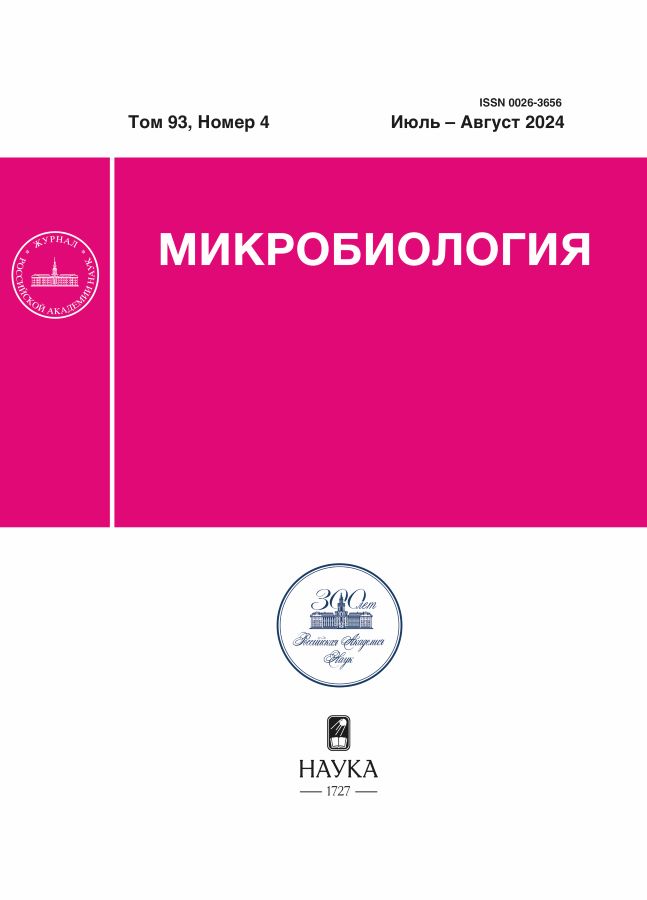New Bacteriophage Pseudomonas Phage Ka1 from a Trivia of Lake Baikal
- Authors: Fedorova M.S.1, Gatina A.E.1, Ilyina V.N.1, Yadykova L.L.1, Dryukker V.V.2, Gorshkova A.S.2, Kayumov A.R.1, Trizna E.Y.1
-
Affiliations:
- Kazan (Volga Region) Federal University
- Limnological Institute, Siberian Branch of the Russian Academy of Sciences
- Issue: Vol 93, No 4 (2024)
- Pages: 474-480
- Section: SHORT COMMUNICATIONS
- URL: https://edgccjournal.org/0026-3656/article/view/655098
- DOI: https://doi.org/10.31857/S0026365624040126
- ID: 655098
Cite item
Abstract
The bacteriophage Pseudomonas phage Ka1 was isolated from the water of a tributary of Lake Baikal, in the area of discharge of treated wastewater in the city of Slyudyanka. The bacteriophage genome is 46,092 bp in size. and 50% composition of G + C pairs (AN OP455935.1) has 91% identity with the genome of Pseudomonas phage PSA37, belonging to the Bruynoghevirus from the class Caudoviricetes, which characterizes it as a new representative of Luz24-like phages (Bruynoghevirus). The bacteriophage lyses 62% of clinical isolates of Pseudomonas aeruginosa and is able to increase the effectiveness of gentamicin, ciprofloxacin, imipinem and meropenem by 4–8 times against this bacterium. Integrases, transposases and recombinases are not identified in the genome, which makes Pseudomonas phage Ka1 possible for use in complex therapy of infections caused by P. aeruginosa.
Full Text
About the authors
M. S. Fedorova
Kazan (Volga Region) Federal University
Author for correspondence.
Email: MaSFedorova97@mail.ru
Russian Federation, 420008, Kazan
A. E. Gatina
Kazan (Volga Region) Federal University
Email: MaSFedorova97@mail.ru
Russian Federation, 420008, Kazan
V. N. Ilyina
Kazan (Volga Region) Federal University
Email: MaSFedorova97@mail.ru
Russian Federation, 420008, Kazan
L. L. Yadykova
Kazan (Volga Region) Federal University
Email: MaSFedorova97@mail.ru
Russian Federation, 420008, Kazan
V. V. Dryukker
Limnological Institute, Siberian Branch of the Russian Academy of Sciences
Email: MaSFedorova97@mail.ru
Russian Federation, 664033, Irkutsk
A. S. Gorshkova
Limnological Institute, Siberian Branch of the Russian Academy of Sciences
Email: MaSFedorova97@mail.ru
Russian Federation, 664033, Irkutsk
A. R. Kayumov
Kazan (Volga Region) Federal University
Email: MaSFedorova97@mail.ru
Russian Federation, 420008, Kazan
E. Y. Trizna
Kazan (Volga Region) Federal University
Email: MaSFedorova97@mail.ru
Russian Federation, 420008, Kazan
References
- Ames B. N. The detection of chemical mutagens with enteric bacteria // Chemical mutagens: principles and methods for their detection. V. 1. Boston, MA: Springer US, 1971. P. 267–282.
- Andrews S., Krueger F., Segonds-Pichon A., Biggins L., Krueger C., Wingett S. FastQC: a quality control tool for high throughput sequence data. 2010.
- Aziz R., Bartels D., Best A., DeJongh M., Disz T., Edwards R., Formsma K., Gerdes S., Glass E., Kubal M., Meyer F., Olsen G., Olson R., Osterman A., Overbeek R., McNeil L., Paarmann D., Paczian T., Parrello B., Pusch1 G., Reich C., Stevens R., Vassieva O., Vonstein V., Wilke A., Zagnitko O. The RAST Server: rapid annotations using subsystems technology // BMC Genomics. 2008. V. 9. Art. 75. P. 1–15.
- Endersen L., Coffey A. The use of bacteriophages for food safety // Curr. Opin. Food Sci. 2020. V. 36. P. 1–8.
- Ferry T., Kolenda C., Laurent F., Leboucher G., Merabischvilli M., Djebara S., Gustave C.-A., Perpoint T., Barrey C., Pirnay J.-P., Resch G. Personalized bacteriophage therapy to treat pandrug-resistant spinal Pseudomonas aeruginosa infection // Nature Commun. 2022. V. 13. Art. 4239.
- Fister S., Mester P., Witte A. K., Sommer J., Schoder D., Rossmanith P. Part of the problem or the solution? Indiscriminate use of bacteriophages in the food industry can reduce their potential and impair growth-based detection methods // Trends Food Sci. Technol. 2019. V. 90. P. 170–174.
- Fong P., Boss D., Yap T., Tutt A., Wu P., Mergui-Roelvink M., Mortimer P., Swaisland H., Lau A., O’Connor M., Ashworth A., Carmichael J., Kaye S., Schellens J., de Bono J. Inhibition of poly (ADP-ribose) polymerase in tumors from BRCA mutation carriers // New England J. Med. 2009. V. 361. P. 123–134.
- Gratia A. Des relations numériques entre bactéries lysogènes et particules de bactériophages // Annales de l’Institut Pasteur. Masson Publishing, France, 1936. Т. 57.
- Guo Z., Lin H., Ji X., Yan G., Lei L., Han W., Gu J., Huang J. Therapeutic applications of lytic phages in human medicine // Microb. Pathogen. 2020. V. 142. Art. 104048.
- Kayumov A., Khakimullina E., Sharafutdinov I., Trizna E., Latypova L., Lien H., Margulis A., Bogachev M., Kurbangalieva A. Inhibition of biofilm formation in Bacillus subtilis by new halogenated furanones // J. Antibiot. 2015. V. 68. P. 297–301.
- Kortright K., Chan B., Koff J., Turner P. Phage therapy: a renewed approach to combat antibiotic-resistant bacteria // Cell Host & Microbe. 2019. V. 25. P. 219–232.
- Leclercq R., Canton R., Brown D., Giske C., Heisig P., MacGowan A., Mouton J., Nordmann P., Rodloff A., Rossolini G., Soussy C.-J., Steinbakk M., Winstanley T., Kahlmeter G. EUCAST expert rules in antimicrobial susceptibility testing // Clin. Microbiol. Infect. 2013. V. 19. P. 141–160.
- Li L., Zhong Q., Zhao Y., Bao J., Liu B., Zhong Z., Wang J., Yang L., Zhang T., Cheng M., Wu N., Zhu T., Le S. First‐in‐human application of double‐stranded RNA bacteriophage in the treatment of pulmonary Pseudomonas aeruginosa infection // Microb. Biotechnol. 2023. V. 16. P. 862–867.
- Mazzocco A., Waddell T., Lingohr E., Johnson R. Enumeration of bacteriophages using the small drop plaque assay system // Bacteriophages: methods and protocols. V. 1: Isolation, characterization, and interactions. 2009. P. 81–85.
- Mielko K., Jabłoński S., Milczewska J., Sands D., Łukaszewicz M., Młynarz P. Metabolomic studies of Pseudomonas aeruginosa // World J. Microbiol. Biotechnol. 2019. V. 35. P. 1–11.
- La Rosa R., Rossi E., Feist A., Johansen H., Molin S. Compensatory evolution of Pseudomonas aeruginosa’s slow growth phenotype suggests mechanisms of adaptation in cystic fibrosis // Nature Commun. 2021. V. 12. Art. 3186.
- Sambrook J., Fritsch E., Maniatis T. Molecular cloning a laboratory manual. Cold Spring Harbor Laboratory Press, 1989. 2nd edn.
- Seemann T. Prokka: rapid prokaryotic genome annotation // Bioinformatics. 2014. V. 30. P. 2068–2069.
Supplementary files











